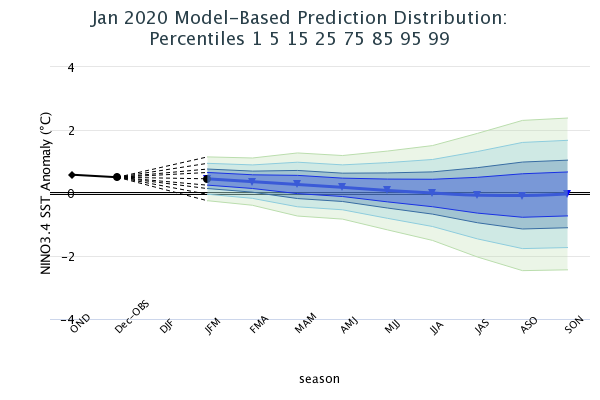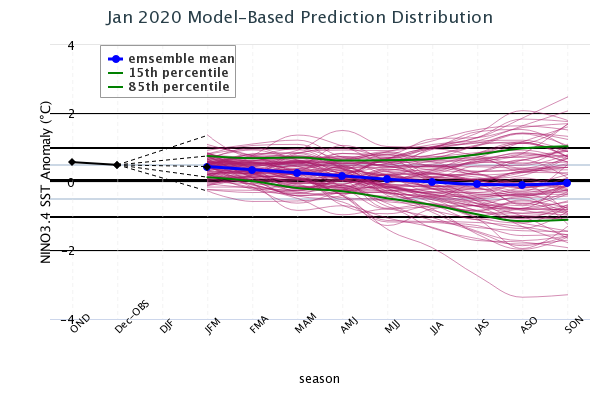IRI ENSO Forecast
IRI Technical ENSO Update and Model-Based Probabilistic ENSO Forecast
Published: January 19, 2020
Note: The SST anomalies cited below refer to the OISSTv2 SST data set, and not ERSSTv4. OISSTv2 is often used for real-time analysis and model initialization, while ERSSTv4 is used for retrospective official ENSO diagnosis because it is more homogeneous over time, allowing for more accurate comparisons among ENSO events that are years apart. During ENSO events, OISSTv2 often shows stronger anomalies than ERSSTv4, and during very strong events the two datasets may differ by as much as 0.5 C. Additionally, the ERSSTv4 may tend to be cooler than OISSTv2, because ERSSTv4 is expressed relative to a base period that is updated every 5 years, while the base period of OISSTv2 is updated every 10 years and so, half of the time, is based on a slightly older period and does not account as much for the slow warming trend in the tropical Pacific SST.
Recent and Current Conditions
In mid-January 2020, SST conditions were near the borderline of weak El Niño in the NINO3.4 region. The December SST anomaly was 0.50 C, right at the threshold for weak El Niño, and for Oct-Dec it was 0.54 C, just over the El Nino threshold. The IRI’s definition of El Niño, like NOAA/Climate Prediction Center’s, requires that the SST anomaly in the Nino3.4 region (5S-5N; 170W-120W) exceed 0.5 C. Similarly, for La Niña, the anomaly must be -0.5 C or less. The climatological probabilities for La Niña, neutral, and El Niño conditions vary seasonally, and are shown in a table at the bottom of this page for each 3-month season. The most recent weekly anomaly in the Nino3.4 region was 0.5 C, at the borderline of warm-neutral and weak El Niño. SST anomalies are near to just slightly above average in the eastern equatorial Pacific, somewhat above average in the central Pacific and more strongly positive in the west-central Pacific. Key atmospheric variables such as the low-level and upper-level zonal wind anomalies, and patterns of sea level pressure and cloudiness and rainfall have been exhibiting mainly neutral ENSO conditions, but slightly trending toward borderline El Nino. Subsurface temperature anomalies from the dateline eastward in the equatorial Pacific became somewhat positive during early January. The borderline warming in the SST is not regarded as indicative of a borderline El Niño when viewed in the context of all of the other ENSO-related variables, such as the atmospheric ones taken collectively.
Expected Conditions
What is the outlook for the ENSO status going forward? The most recent official diagnosis and outlook was issued approximately one week ago in the NOAA/Climate Prediction Center ENSO Diagnostic Discussion, produced jointly by CPC and IRI; it states that neutral conditions are most likely to continue through the spring and summer. The latest set of model ENSO predictions from mid-January, now available in the IRI/CPC ENSO prediction plume, is next discussed: As of mid-January, 35% of the dynamical or statistical models predict El Niño conditions for the Jan-Mar season, while 65% predicts ENSO-neutral. Going forward, a greater percentage of models predict neutral conditions than El Niño or La Niña for all seasons through the final season of Sep-Nov. The percentage of models predicting neutral is 69% for Feb-Apr, rises to near 75% for Apr-Jun and May-Jul, and then falls to near 50% by Aug-Oct and Sep-Nov. Percentages of models predicting El Niño drop from 35% in Jan-Mar to approximately 20% during Apr-Jun through Sep-Nov. No model predicts La Niña for Jan-Mar and Feb-Apr; thereafter the percentage of models calling for La Niña rises to 14% by Jun-Aug and to approximately 25% by Aug-Oct and Sep-Nov.
Note – Only models that produce a new ENSO prediction every month are included in the above statement.
Caution is advised in interpreting the distribution of model predictions as the actual probabilities. At longer leads, the skill of the models degrades, and skill uncertainty must be convolved with the uncertainties from initial conditions and differing model physics, leading to more climatological probabilities in the long-lead ENSO Outlook than might be suggested by the suite of models. Furthermore, the expected skill of one model versus another has not been established using uniform validation procedures, which may cause a difference in the true probability distribution from that taken verbatim from the raw model predictions.
An alternative way to assess the probabilities of the three possible ENSO conditions is more quantitatively precise and less vulnerable to sampling errors than the categorical tallying method used above. This alternative method uses the mean of the predictions of all models on the plume, equally weighted, and constructs a standard error function centered on that mean. The standard error is Gaussian in shape, and has its width determined by an estimate of overall expected model skill for the season of the year and the lead time. Higher skill results in a relatively narrower error distribution, while low skill results in an error distribution with width approaching that of the historical observed distribution. Using this method, chances for El Niño are 43% for the Jan-Mar season, and chances for ENSO-neutral are 57%. Going forward, probabilities for neutral are higher than those for El Niño or La Niña for all seasons through the final season of Sep-Nov. Probabilities for neutral are 68% for Feb-Apr, rise to over 75% for Mar-May and Apr-Jun, and slowly fall to below 50% by Aug-Oct. El Niño probabilities drop from 43% to 20% from Jan-Mar to Apr-Jun, and then remain between 20% and 25% through Aug-Oct before rising to 29% for Sep-Nov. Chances for La Niña are near-zero through Mar-May, rise to 14% by May-Jul and reach 30% by Aug-Oct. A plot of the probabilities generated from this most recent IRI/CPC ENSO prediction plume using the multi-model mean and the Gaussian standard error method summarizes the model consensus out to about 10 months into the future.
The same cautions mentioned above for the distributional count of model predictions apply to this Gaussian standard error method of inferring probabilities, due to differing model biases and skills. In particular, this approach considers only the mean of the predictions, and not the total range across the models, nor the ensemble range within individual models.
In summary, the probabilities derived from the models on the IRI/CPC plume describe, on average, a preference for neutral ENSO conditions relative to El Niño or La Niña for all forecast seasons. El Niño is more likely than La Niña through the May-Jul forecast period, while La Niña is very slightly more likely than El Niño from Jul-Sep through Sep-Nov. A caution regarding this latest set of model-based ENSO plume predictions, is that factors such as known specific model biases and recent changes that the models may have missed will be taken into account in the next official outlook to be generated and issued early next month by CPC and IRI, which will include some human judgment in combination with the model guidance.

IRI/CPC Mid-Month Model-Based ENSO Forecast Probabilities
| Season |
La Niña |
Neutral |
El Niño |
| JFM 2020 |
0% |
57% |
43% |
| FMA 2020 |
0% |
68% |
32% |
| MAM 2020 |
1% |
76% |
23% |
| AMJ 2020 |
3% |
77% |
20% |
| MJJ 2020 |
14% |
64% |
22% |
| JJA 2020 |
22% |
56% |
22% |
| JAS 2020 |
28% |
51% |
21% |
| ASO 2020 |
30% |
46% |
24% |
| SON 2020 |
31% |
40% |
29% |





